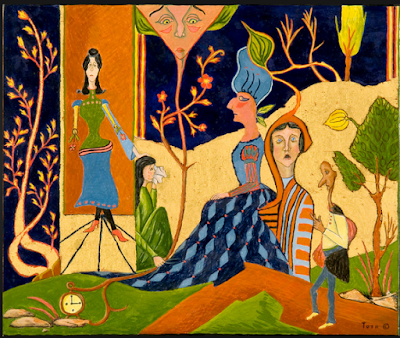 |
| Necklace by Myong Urso |
Lily wore earrings every day. Lily was 80 plus years old and her ears were pierced — probably from the time she was a child, maybe even a baby. She was European.
I knew Lily for more than twenty years. I never saw her without those pearl and diamond earrings. They weren’t that big as earrings go. But these must have been heavy because Lily’s earlobes were stretched toward her shoulders. The earrings hung at approximately a hundred degree angle looking toward her neck. It was something you couldn’t help but notice.
Lily was a bohemian. One time she appeared at a party in a full-out-German-girl-native-outfit complete with embroidered vest and full dirndl skirt. And those diamond and pearl earrings. She demanded attention.
The earring thing scared me a little. I wondered if Lily had unusually thin ear lobes which eventually stretched. Or if never taking earrings off led to elongation of the lobes. I wear pearl studs in my own pierced ears and I rarely take them off. Will I too have lobes that sag along with all the rest of me? (My other parts got a head start. The ears will need to stretch over-time!)
In 1982, Gloria bought a beautiful silver cuff bracelet from Dawson Gallery. The gallery was still young and Gloria was old. We had an exhibition of jewelry by somebody I’ve since forgotten. Pieces were gorgeous but expensive. Gloria, a sweet, grandmotherly woman, swooped in, tried on one of the most expensive and promptly bought it for herself.
I saw Gloria wear the bracelet once. She had on a tailored wool tweed suit. And the bracelet. I was taken aback .No!No!No! That bracelet needed a silk shirt. And a younger body, preferably complementing a beautiful face and flowing hair that got tossed around in flirtatious conversation. Nothing about Gloria was “flirtatious.”
Wait! What was I thinking? Jewelry discrimination! Do women age out of jewelry? Do our daughters cringe when we waltz out to the kitchen wearing yoga pants and cocktail rings? Diamonds may be a girl’s best friend but what about a grandmother? Are we meant to stick to lace and cameos? Will the day come when we need to put away the chunky bracelets along with the car keys and deep red lipstick?
I bought myself a new necklace last week. Myong Urso designed it. She’s Korean. And petite. And has great hair.
The necklace is longer than normal but can be hitched up or wound twice. It’s made of 4 different hand-made sections of metal chain. Two elements — a large amber bead and a 3 inch straight piece of bamboo — are randomly threaded on the chain length.
The necklace is pretty dramatic. To pull it off to best effect, it needs to be worn by a woman much taller than me. And younger. One who can wear a slinky black cocktail dress. And toss her hair. I can’t toss my hair.
I still like the necklace.
```````````````````````````````````````````
Happy Holidays, everybody. And thanks for reading my ramblings.























